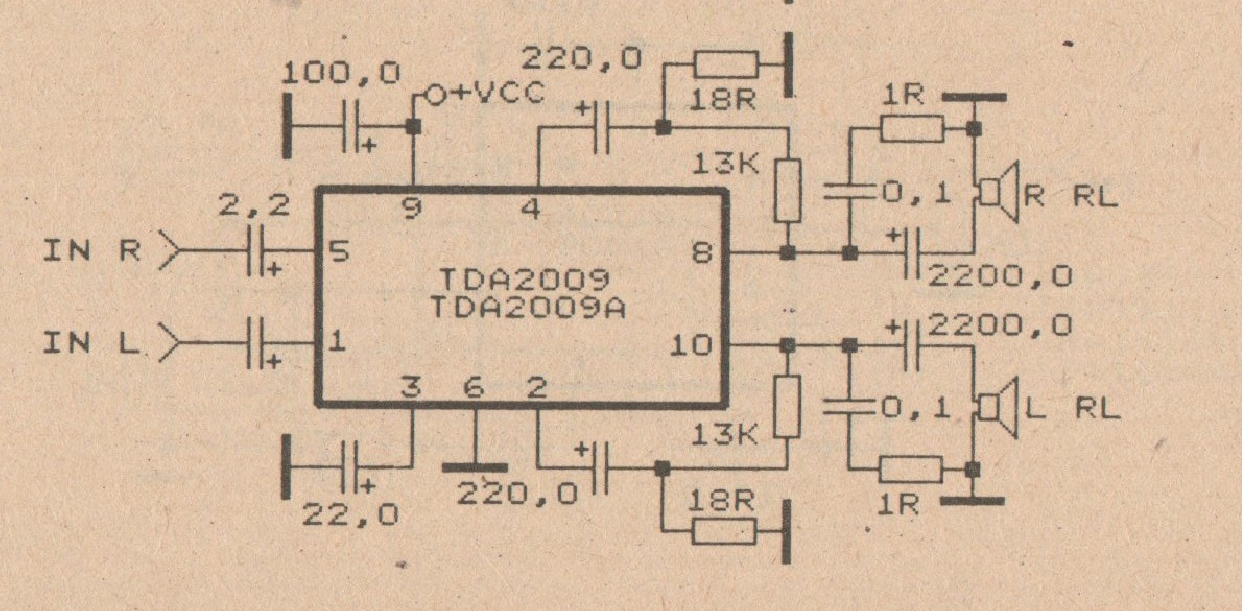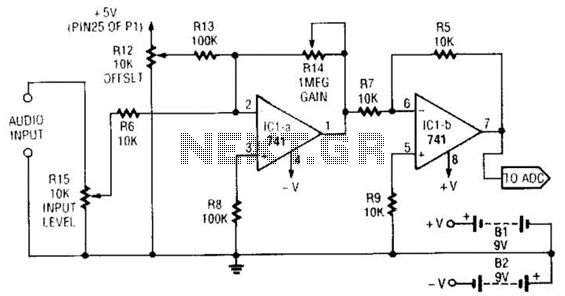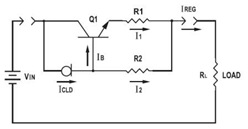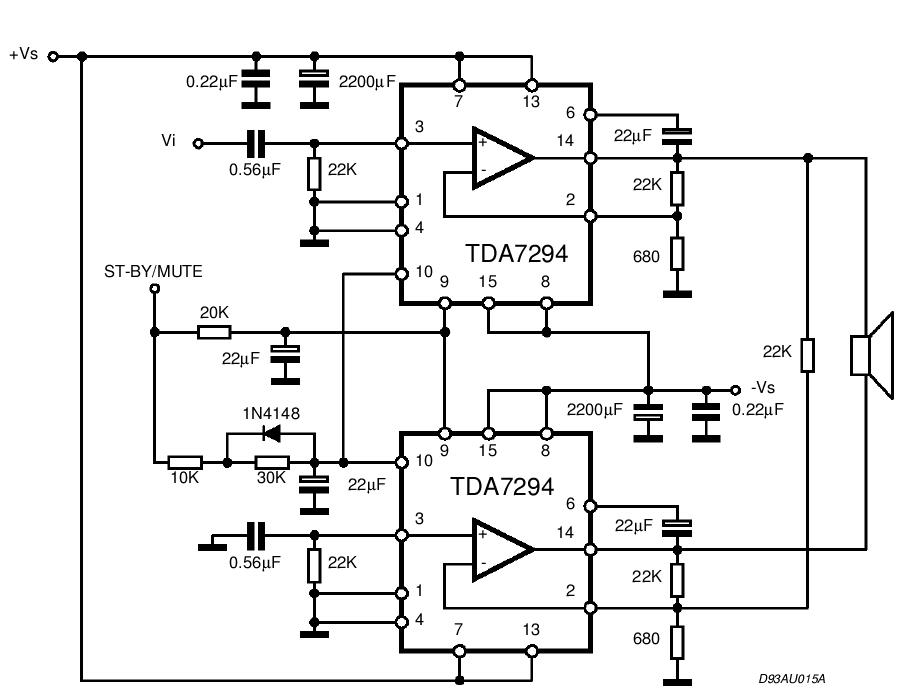
Inductive radio alarm circuit
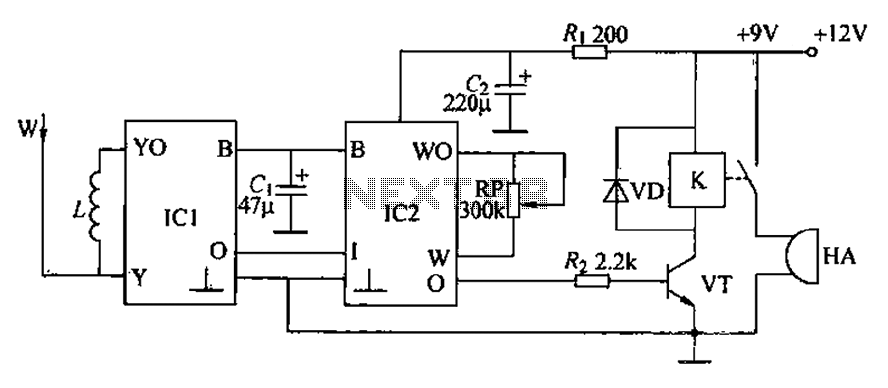
A circuit for an inductive burglar alarm is derived from a radio scanning detection circuit, which includes a signal processing circuit and an alarm circuit. The radar detection circuit module consists of components such as microwave emission, low-pass filtering, and gating amplification circuit (IC1), along with an inductor (L) and antenna (W). The signal processing circuit module (IC2) is responsible for identifying the amplified signals and includes a regulator, amplified strobe, soft start, comparison amplification, and delay driving circuitry, along with capacitors (Ci, Cz), a resistor (R), and a potentiometer (RP). The alarm circuit is composed of a resistor (Rz), a crystal tube (VT), two drop-tubes (VD), a relay (K), and an alarm (HA), utilizing a microwave oscillator signal at approximately 1000 MHz. The alarm operates on the principle that the internal oscillation circuit of IC1 emits high-frequency electromagnetic waves into the surrounding space through the antenna. When there are no moving objects within the radar detection zone, IC2 maintains a low output at terminal 0, keeping VT in an off state, relay K released, and alarm HA silent. However, if a person moves within the effective range of the radio control scanning detection circuit, the changing magnetic field is detected by the antenna, and IC1 processes the echo signal through low-pass filtering. The output from IC1 then generates an ultra-low frequency signal, which IC2 amplifies and processes through strobe delay, resulting in a high output that turns on VT, activates relay K, and powers the alarm HA to emit a loud sound.
The inductive burglar alarm circuit is designed to provide an effective security solution by utilizing microwave radar technology to detect movement within its operational range. The circuit's functionality relies on the interaction between various components that work in unison to detect disturbances in the electromagnetic field caused by the presence of a person.
The radar detection module (IC1) emits microwave signals and monitors the surrounding environment for any changes. When the area is clear, the output remains low, preventing any alarm activation. The antenna plays a crucial role in transmitting and receiving these microwave signals, ensuring that even slight movements can be detected.
Once movement is detected, the echo signal from IC1 is processed through low-pass filters to eliminate noise and enhance the signal quality. The processed signal is then fed into the signal processing module (IC2), where it undergoes further amplification and delay processing. These steps are essential for ensuring that the alarm system does not trigger from minor disturbances or false positives, providing a reliable response only to significant movements.
The alarm circuit is strategically designed to activate a loud alarm (HA) when the relay (K) is triggered by the output from IC2. The use of a crystal tube (VT) and drop-tubes (VD) helps to manage the current flow and ensure that the alarm operates effectively. The inclusion of a potentiometer (RP) allows for fine-tuning of the circuit's sensitivity, enabling customization based on the specific requirements of the installation environment.
Overall, this inductive burglar alarm circuit exemplifies an advanced approach to security systems, combining radio wave technology with electronic circuit design to create a responsive and reliable alarm mechanism. Circuit inductive burglar alarm circuit from the radio scanning detection circuit, a signal processing circuit and alarm circuit, as shown in Figure 13-43. Radar detected by th e radar detection circuit module block (containing microwave emission, low-pass filtering, gating amplification circuit) IC1, W and antenna inductor L components. Identifying amplified by a signal processing circuit module block IC2 (includes regulator, amplified strobe, soft start, comparing amplification, delay isoelectric driving road), a capacitor Ci, Cz, resistor R.
And potentiometer RP. Alarm circuit by the resistor Rz, crystal tube VT, two drop-tube VD, relay K and alarm HA, microwave oscillator signal (about 1000MHz) (2) Alarm principle IC1 internal oscillation circuit generated by the antenna to the surrounding space W emit high-frequency electromagnetic waves. Scanning radar detection zone within no moving objects, IC2 control output terminal (terminal 0) output low, VT is in ending state.
K in a released state. HA is not sound. When someone moves within the effective range of the radio control scanning detection circuit, the magnetic field space will change. W antenna will detect human body after moving away IC1 points echo signal low-pass processing, the signal output terminal of Ic1 (O side) ultra-low frequency output signal, which is by the IC2 further amplification and strobe delayed drive processing, high output from the control output power peace, so that VT conduction, the relay pull-K, HA powered loud alarm sound.
The inductive burglar alarm circuit is designed to provide an effective security solution by utilizing microwave radar technology to detect movement within its operational range. The circuit's functionality relies on the interaction between various components that work in unison to detect disturbances in the electromagnetic field caused by the presence of a person.
The radar detection module (IC1) emits microwave signals and monitors the surrounding environment for any changes. When the area is clear, the output remains low, preventing any alarm activation. The antenna plays a crucial role in transmitting and receiving these microwave signals, ensuring that even slight movements can be detected.
Once movement is detected, the echo signal from IC1 is processed through low-pass filters to eliminate noise and enhance the signal quality. The processed signal is then fed into the signal processing module (IC2), where it undergoes further amplification and delay processing. These steps are essential for ensuring that the alarm system does not trigger from minor disturbances or false positives, providing a reliable response only to significant movements.
The alarm circuit is strategically designed to activate a loud alarm (HA) when the relay (K) is triggered by the output from IC2. The use of a crystal tube (VT) and drop-tubes (VD) helps to manage the current flow and ensure that the alarm operates effectively. The inclusion of a potentiometer (RP) allows for fine-tuning of the circuit's sensitivity, enabling customization based on the specific requirements of the installation environment.
Overall, this inductive burglar alarm circuit exemplifies an advanced approach to security systems, combining radio wave technology with electronic circuit design to create a responsive and reliable alarm mechanism. Circuit inductive burglar alarm circuit from the radio scanning detection circuit, a signal processing circuit and alarm circuit, as shown in Figure 13-43. Radar detected by th e radar detection circuit module block (containing microwave emission, low-pass filtering, gating amplification circuit) IC1, W and antenna inductor L components. Identifying amplified by a signal processing circuit module block IC2 (includes regulator, amplified strobe, soft start, comparing amplification, delay isoelectric driving road), a capacitor Ci, Cz, resistor R.
And potentiometer RP. Alarm circuit by the resistor Rz, crystal tube VT, two drop-tube VD, relay K and alarm HA, microwave oscillator signal (about 1000MHz) (2) Alarm principle IC1 internal oscillation circuit generated by the antenna to the surrounding space W emit high-frequency electromagnetic waves. Scanning radar detection zone within no moving objects, IC2 control output terminal (terminal 0) output low, VT is in ending state.
K in a released state. HA is not sound. When someone moves within the effective range of the radio control scanning detection circuit, the magnetic field space will change. W antenna will detect human body after moving away IC1 points echo signal low-pass processing, the signal output terminal of Ic1 (O side) ultra-low frequency output signal, which is by the IC2 further amplification and strobe delayed drive processing, high output from the control output power peace, so that VT conduction, the relay pull-K, HA powered loud alarm sound.


